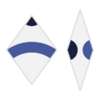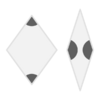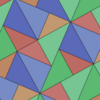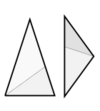List of aperiodic sets of tiles

In geometry, a tiling is a partition of the plane (or any other geometric setting) into closed sets (called tiles), without gaps or overlaps (other than the boundaries of the tiles).[1] A tiling is considered periodic if there exist translations in two independent directions which map the tiling onto itself. Such a tiling is composed of a single fundamental unit or primitive cell which repeats endlessly and regularly in two independent directions.[2] An example of such a tiling is shown in the adjacent diagram (see the image description for more information). A tiling that cannot be constructed from a single primitive cell is called nonperiodic. If a given set of tiles allows only nonperiodic tilings, then this set of tiles is called aperiodic.[3] The tilings obtained from an aperiodic set of tiles are often called aperiodic tilings, though strictly speaking it is the tiles themselves that are aperiodic. (The tiling itself is said to be "nonperiodic".)
The first table explains the abbreviations used in the second table. The second table contains all known aperiodic sets of tiles and gives some additional basic information about each set. This list of tiles is still incomplete.
Explanations
| Abbreviation | Meaning | Explanation |
|---|---|---|
| E2 | Euclidean plane | normal flat plane |
| H2 | hyperbolic plane | plane, where the parallel postulate does not hold |
| E3 | Euclidean 3 space | space defined by three perpendicular coordinate axes |
| MLD | Mutually locally derivable | two tilings are said to be mutually locally derivable from each other, if one tiling can be obtained from the other by a simple local rule (such as deleting or inserting an edge) |
List
| Image | Name | Number of tiles | Space | Publication Date | Refs. | Comments |
|---|---|---|---|---|---|---|
 |
Trilobite and cross tiles | 2 | E2 | 1999 | [4] | Tilings MLD from the chair tilings. |
 |
Penrose P3 tiles | 2 | E2 | 1978[5] | [6] | Tilings MLD from the tilings by P1 and P2, Robinson triangles, and "Starfish, ivy leaf, hex". |
 |
Binary tiles | 2 | E2 | 1988 | [7][8] | Although similar in shape to the P3 tiles, the tilings are not MLD from each other. Developed in an attempt to model the atomic arrangement in binary alloys. |
 |
Robinson tiles | 6 | E2 | 1971[9] | [10] | Tiles enforce aperiodicity by forming an infinite hierarchy of square lattices. |
 |
Ammann A3 tiles | 3 | E2 | 1986[11] | [12] | |
 |
Ammann A5 tiles | 2 | E2 | 1982[13] | [14][15] | Tilings MLD with Ammann A4. |
| No image | Pegasus tiles | 2 | E2 | 2016[16] | [16][17] | Variant of the Penrose hexagon-triangle tiles. Discovered in 2003 or earlier. |
 |
Golden triangle tiles | 10 | E2 | 2001[18] | [19] | Date is for discovery of matching rules. Dual to Ammann A2. |
 |
Socolar tiles | 3 | E2 | 1989[20] | [21][22] | Tilings MLD from the tilings by the Shield tiles. |
| Shield tiles | 4 | E2 | 1988[23] | [24][25] | Tilings MLD from the tilings by the Socolar tiles. | |
 |
Square triangle tiles | 5 | E2 | 1986[26] | [27] | |
 |
Robinson triangle | 4 | E2 | [11] | Tiling is MLD to Penrose P1, P2, P3, and "Starfish, ivy leaf, hex". | |
 |
Danzer triangles | 6 | E2 | 1996[28] | [29] | |
 |
Socolar–Taylor tile | 1 | E2 | 2010 | [30][31] | Not a connected set. Aperiodic hierarchical tiling. |
| No image | Wang tiles | 20426 | E2 | 1966 | [32] | |
| No image | Wang tiles | 104 | E2 | 2008 | [33] | |
| No image | Wang tiles | 24 | E2 | 1986 | [34] | Locally derivable from the A2 tiling. |
 |
Wang tiles | 16 | E2 | 1986 | [11][35] | Derived from tiling A2 and its Ammann bars. |
 |
Wang tiles | 11 | E2 | 2015 | [36] | Smallest aperiodic set of Wang tiles. |
| No image | Decagonal Sponge tile | 1 | E2 | 2002 | [37][38] | Porous tile consisting of non-overlapping point sets. |
| No image | Goodman-Strauss strongly aperiodic tiles | 85 | H2 | 2005 | [39] | |
| No image | Goodman-Strauss strongly aperiodic tiles | 26 | H2 | 2005 | [40] | |
 |
Böröczky hyperbolic tile | 1 | Hn | 1974[41][42] | [40][43] | Only weakly aperiodic. |
| No image | Schmitt tile | 1 | E3 | 1988 | [44] | Screw-periodic. |
 |
Schmitt–Conway–Danzer tile | 1 | E3 | [44] | Screw-periodic and convex. | |
 |
Socolar–Taylor tile | 1 | E3 | 2010 | [30][31] | Periodic in third dimension. |
| No image | Penrose rhombohedra | 2 | E3 | 1981[45] | [46][47][48][49][50][51][52] | |
 |
Mackay–Amman rhombohedra | 4 | E3 | 1981 | [53] | Icosahedral symmetry. These are decorated Penrose rhombohedra with a matching rule that force aperiodicity. |
| No image | Wang cubes | 18 | E3 | 1999 | [54] | |
| No image | Danzer tetrahedra | 4 | E3 | 1989[55] | [56] | |
 |
I and L tiles | 2 | En for all n ≥ 3 | 1999 | [57] | |
 |
Smith–Myers–Kaplan–Goodman-Strauss or "Hat" polytile | 1 | E2 | 2023 | [58] | Mirrored monotiles, the first example of an "einstein". |
 |
Smith–Myers–Kaplan–Goodman-Strauss or "Spectre" polytile | 1 | E2 | 2023 | [59] | "Strictly chiral" aperiodic monotile, the first example of a real "einstein". |
 |
TS1 | 2 | E2 | 2014 | [60] |
References
- ↑ Grünbaum, Branko; Shephard, Geoffrey C. (1977), "Tilings by Regular Polygons", Math. Mag. 50 (5): 227–247, doi:10.2307/2689529
- ↑ Edwards, Steve, Fundamental Regions and Primitive cells, Kennesaw State University, http://ksuweb.kennesaw.edu/~sedwar77/tile/defs/fundamental.htm, retrieved 2017-01-11
- ↑ Wagon, Steve (2010), Mathematica in Action (3rd ed.), Springer Science & Business Media, pp. 268, ISBN 9780387754772, https://books.google.com/books?id=EbVrWLNiub4C&q=nonperiodic+tiling&pg=PA268
- ↑ Goodman-Strauss, Chaim (1999), "A Small Aperiodic Set of Planar Tiles", European J. Combin. 20 (5): 375–384, doi:10.1006/eujc.1998.0281 (preprint available)
- ↑ Penrose, Roger (1978), "Pentaplexity", Eureka 39: 16–22, https://www.archim.org.uk/eureka/archive/Eureka-39.pdf
- ↑ Penrose, Roger (1979), "Pentaplexity", Math. Intell. 2 (1): 32–37, doi:10.1007/bf03024384, http://www.ma.utexas.edu/users/radin/pentaplexity.html, retrieved 2010-07-26
- ↑ Lançon, F.; Billard, L. (1988), "Two-dimensional system with a quasi-crystalline ground state", Journal de Physique 49 (2): 249–256, doi:10.1051/jphys:01988004902024900, http://hal.archives-ouvertes.fr/docs/00/21/06/91/PDF/ajp-jphys_1988_49_2_249_0.pdf
- ↑ Godrèche, C.; Lançon, F. (1992), "A simple example of a non-Pisot tiling with five-fold symmetry", Journal de Physique I 2 (2): 207–220, doi:10.1051/jp1:1992134, Bibcode: 1992JPhy1...2..207G, http://hal.archives-ouvertes.fr/docs/00/24/64/73/PDF/ajp-jp1v2p207.pdf
- ↑ Robinson, Raphael M. (1971), "Undecidability and nonperiodicity of tilings in the plane", Inventiones Mathematicae 12 (3): 177–209, doi:10.1007/BF01418780, Bibcode: 1971InMat..12..177R
- ↑ Goodman-Strauss, Chaim (1999), Sadoc, J. F.; Rivier, N., eds., "Aperiodic Hierarchical tilings", NATO ASI Series, Series E: Applied Sciences 354 (Foams and Emulsions): 481–496, doi:10.1007/978-94-015-9157-7_28, ISBN 978-90-481-5180-6
- ↑ 11.0 11.1 11.2 Cite error: Invalid
<ref>tag; no text was provided for refs namedTilPat - ↑ Cite error: Invalid
<ref>tag; no text was provided for refs namedAperiodic tiles - ↑ Beenker, F. P. M. (1982), Algebraic theory of non-periodic tilings of the plane by two simple building blocks: a square and a rhombus, TH Report, 82-WSK04, Eindhoven University of Technology
- ↑ Komatsu, Kazushi; Nomakuchi, Kentaro; Sakamoto, Kuniko; Tokitou, Takashi (2004), "Representation of Ammann-Beenker tilings by an automaton", Nihonkai Math. J. 15 (2): 109–118, http://projecteuclid.org/euclid.nihmj/1273779794, retrieved 2017-01-12
- ↑ Harriss, Edmund; Frettlöh, Dirk, Ammann-Beenker, Bielefeld University, http://tilings.math.uni-bielefeld.de/substitution/ammann-beenker/
- ↑ 16.0 16.1 Goodman-Strauss, Chaim (2016). "The Pegasus Tiles: an aperiodic pair of tiles". arXiv:1608.07166 [math.CO].
- ↑ Goodman-Strauss, Chaim (2003), An aperiodic pair of tiles, University of Arkansas, http://comp.uark.edu/~strauss/distribution/tilings/penhex.pdf
- ↑ Danzer, Ludwig; van Ophuysen, Gerrit (2001), "A species of planar triangular tilings with inflation factor ", Res. Bull. Panjab Univ. Sci. 50 (1–4): 137–175
- ↑ Gelbrich, G (1997), "Fractal Penrose tiles II. Tiles with fractal boundary as duals of Penrose triangles", Aequationes Mathematicae 54 (1–2): 108–116, doi:10.1007/bf02755450
- ↑ Socolar, Joshua E. S. (1989), "Simple octagonal and dodecagonal quasicrystals", Physical Review B 39 (15): 10519–51, doi:10.1103/PhysRevB.39.10519, PMID 9947860, Bibcode: 1989PhRvB..3910519S
- ↑ Gähler, Franz; Lück, Reinhard; Ben-Abraham, Shelomo I.; Gummelt, Petra (2001), "Dodecagonal tilings as maximal cluster coverings", Ferroelectrics 250 (1): 335–338, doi:10.1080/00150190108225095, Bibcode: 2001Fer...250..335G
- ↑ Savard, John J. G., The Socolar tiling, http://www.quadibloc.com/math/dode01.htm
- ↑ Gähler, Franz (1988), "Crystallography of dodecagonal quasicrystals"", in Janot, Christian, Quasicrystalline materials: Proceedings of the I.L.L. / Codest Workshop, Grenoble, 21–25 March 1988, Singapore: World Scientific, pp. 272–284, http://elib.uni-stuttgart.de/opus/volltexte/2009/4662/pdf/gaeh7.pdf
- ↑ Gähler, Franz; Frettlöh, Dirk, Shield, Bielefeld University, http://tilings.math.uni-bielefeld.de/substitution/shield/
- ↑ Gähler, Franz (1993), "Matching rules for quasicrystals: the composition-decomposition method", Journal of Non-Crystalline Solids 153–154 (Proceddings of the Fourth International Conference on Quasicrystals): 160–164, doi:10.1016/0022-3093(93)90335-u, Bibcode: 1993JNCS..153..160G, http://elib.uni-stuttgart.de/opus/volltexte/2009/3989/pdf/gaeh11.pdf
- ↑ Stampfli, P. (1986), "A Dodecagonal Quasiperiodic Lattice in Two Dimensions", Helv. Phys. Acta 59: 1260–1263
- ↑ Hermisson, Joachim; Richard, Christoph; Baake, Michael (1997), "A Guide to the Symmetry Structure of Quasiperiodic Tiling Classes", Journal de Physique I 7 (8): 1003–1018, doi:10.1051/jp1:1997200, Bibcode: 1997JPhy1...7.1003H, https://hal.archives-ouvertes.fr/jpa-00247374
- ↑ Nischke, K.-P.; Danzer, L. (1996), "A construction of inflation rules based on n-fold symmetry", Discrete & Computational Geometry 15 (2): 221–236, doi:10.1007/bf02717732
- ↑ Hayashi, Hiroko; Kawachi, Yuu; Komatsu, Kazushi; Konda, Aya; Kurozoe, Miho; Nakano, Fumihiko; Odawara, Naomi; Onda, Rika et al. (2009), "Abstract: Notes on vertex atlas of planar Danzer tiling", Japan Conference on Computational Geometry and Graphs, Kanazawa, November 11–13, 2009, http://www.jaist.ac.jp/~uehara/JCCGG09/short/paper_29.pdf
- ↑ 30.0 30.1 Socolar, Joshua E. S.; Taylor, Joan M. (2011), "An aperiodic hexagonal tile", Journal of Combinatorial Theory, Series A 118 (8): 2207–2231, doi:10.1016/j.jcta.2011.05.001
- ↑ 31.0 31.1 Socolar, Joshua E. S.; Taylor, Joan M. (2011), "Forcing nonperiodicity with a single tile", The Mathematical Intelligencer 34 (1): 18–28, doi:10.1007/s00283-011-9255-y
- ↑ Berger, Robert (1966), "The Undecidability of the Domino Problem", Memoirs of the American Mathematical Society 66 (66), doi:10.1090/memo/0066, ISBN 978-0-8218-1266-2
- ↑ Ollinger, Nicolas (2008), "Two-by-two Substitution Systems and the Undecidability of the Domino Problem", Logic and Theory of Algorithms, Lecture Notes in Computer Science, 5028, Springer, pp. 476–485, doi:10.1007/978-3-540-69407-6_51, ISBN 978-3-540-69405-2, http://hal.inria.fr/docs/00/26/01/12/PDF/sutica.pdf
- ↑ Cite error: Invalid
<ref>tag; no text was provided for refs namedAperiodic sets of square tiles - ↑ Carbone, Alessandra; Gromov, Mikhael; Prusinkiewicz, Przemyslaw (2000), Pattern Formation in Biology, Vision and Dynamics, Singapore: World Scientific, ISBN 978-981-02-3792-9
- ↑ Jeandel, Emmanuel; Rao, Michaël (2021), "An aperiodic set of 11 Wang tiles", Advances in Combinatorics: Paper No. 1, 37, doi:10.19086/aic.18614
- ↑ Zhu, Feng (2002), The Search for a Universal Tile, Williams College, http://www.cs.williams.edu/~bailey/Zh02.pdf
- ↑ Bailey, Duane A.; Zhu, Feng (2001), A Sponge-Like (Almost) Universal Tile, http://cs.williams.edu/~bailey/BaileyZhu.pdf
- ↑ Goodman-Strauss, Chaim (2010), "A hierarchical strongly aperiodic set of tiles in the hyperbolic plane", Theoretical Computer Science 411 (7–9): 1085–1093, doi:10.1016/j.tcs.2009.11.018, http://comp.uark.edu/~strauss/papers/STAP.pdf
- ↑ 40.0 40.1 Goodman-Strauss, Chaim (2005), "A strongly aperiodic set of tiles in the hyperbolic plane", Invent. Math. 159 (1): 130–132, doi:10.1007/s00222-004-0384-1, Bibcode: 2004InMat.159..119G
- ↑ Böröczky, K. (1974), "Gömbkitöltések állandó görbületü terekben I", Matematikai Lapok 25: 265–306
- ↑ Böröczky, K. (1974), "Gömbkitöltések állandó görbületü terekben II", Matematikai Lapok 26: 67–90
- ↑ Dolbilin, Nikkolai; Frettlöh, Dirk (2010), "Properties of Böröczky tilings in high dimensional hyperbolic spaces", European J. Combin. 31 (4): 1181–1195, doi:10.1016/j.ejc.2009.11.016, http://www.mathematik.uni-bielefeld.de/baake/frettloe/papers/hypart.pdf
- ↑ 44.0 44.1 Radin, Charles (1995), "Aperiodic tilings in higher dimensions", Proceedings of the American Mathematical Society (American Mathematical Society) 123 (11): 3543–3548, doi:10.2307/2161105, http://www.ma.utexas.edu/users/radin/papers/schmitt.pdf, retrieved 2013-09-25
- ↑ Mackay, Alan L. (1981), "De Nive Quinquangula: On the pentagonal snowflake", Sov. Phys. Crystallogr. 26 (5): 517–522, http://materials.iisc.ernet.in/~lord/webfiles/Alan/CV073eng.pdf
- ↑ Meisterernst, Götz, Experimente zur Wachstumskinetik Dekagonaler Quasikristalle, Ludwig Maximilian University of Munich, pp. 18–19, http://edoc.ub.uni-muenchen.de/7000/1/Meisterernst_Goetz.pdf
- ↑ Jirong, Sun (1993), "Structure Transition of the Three-Dimensional Penrose Tiling Under Phason Strain Field", Chinese Physics Letters 10 (8): 449–452, doi:10.1088/0256-307x/10/8/001, Bibcode: 1993ChPhL..10..449S
- ↑ Inchbald, Guy (2002), A 3-D Quasicrystal Structure, https://www.steelpillow.com/polyhedra/quasicr/quasicr.html
- ↑ Lord, E. A.; Ranganathan, S.; Kulkarni, U. D. (2001), "Quasicrystals: tiling versus clustering", Philosophical Magazine A 81 (11): 2645–2651, doi:10.1080/01418610108216660, Bibcode: 2001PMagA..81.2645L, http://materials.iisc.ernet.in/~lord/webfiles/pmq.pdf
- ↑ Rudhart, Christoph Paul (June 1999), Zur numerischen Simulation des Bruchs von Quasikristallen, University of Stuttgart, p. 11, doi:10.18419/opus-4639, http://elib.uni-stuttgart.de/handle/11682/4656
- ↑ Lord, E. A.; Ranganathan, S.; Kulkarni, U. D. (2000), "Tilings, coverings, clusters and quasicrystals", Current Science 78 (1): 64–72, http://www.currentscience.ac.in/Downloads/article_id_078_01_0064_0072_0.pdf
- ↑ Katz, A. (1988), "Theory of Matching Rules for the 3-Dimensional Penrose Tilings", Communications in Mathematical Physics 118 (2): 263–288, doi:10.1007/BF01218580, Bibcode: 1988CMaPh.118..263K, http://projecteuclid.org/euclid.cmp/1104161989
- ↑ Cite error: Invalid
<ref>tag; no text was provided for refs namedQuasicrystals and Penrose patterns - ↑ Walther. Gerd; Selter, Christoph, eds. (1999), Mathematikdidaktik als design science : Festschrift für Erich Christian Wittmann, Leipzig: Ernst Klett Grundschulverlag, ISBN 978-3-12-200060-8
- ↑ Danzer, L. (1989), "Three-Dimensional Analogs of the Planar Penrose Tilings and Quasicrystals", Discrete Mathematics 76 (1): 1–7, doi:10.1016/0012-365X(89)90282-3
- ↑ Zerhusen, Aaron (1997), Danzer's three dimensional tiling, University of Kentucky, http://www.ms.uky.edu/~lee/zerhusen/quasi.html
- ↑ Goodman-Strauss, Chaim (1999), "An Aperiodic Pair of Tiles in En for all n ≥ 3", European J. Combin. 20 (5): 385–395, doi:10.1006/eujc.1998.0282 (preprint available)
- ↑ Smith, David; Myers, Joseph Samuel; Kaplan, Craig S.; Goodman-Strauss, Chaim (2023). "An aperiodic monotile". arXiv:2303.10798 [math.CO].
- ↑ Smith, David; Myers, Joseph Samuel; Kaplan, Craig S.; Goodman-Strauss, Chaim (2023). "A chiral aperiodic monotile". arXiv:2305.17743 [math.CO].
- ↑ Mehta, Chirag (2021-04-03). "The art of what if" (in en). Journal of Mathematics and the Arts 15 (2): 198–200. doi:10.1080/17513472.2021.1919977. ISSN 1751-3472. https://www.tandfonline.com/doi/full/10.1080/17513472.2021.1919977.
External links
- Stephens P. W., Goldman A. I. The Structure of Quasicrystals
- Levine D., Steinhardt P. J. Quasicrystals I Definition and structure
- Tilings Encyclopedia
 |


